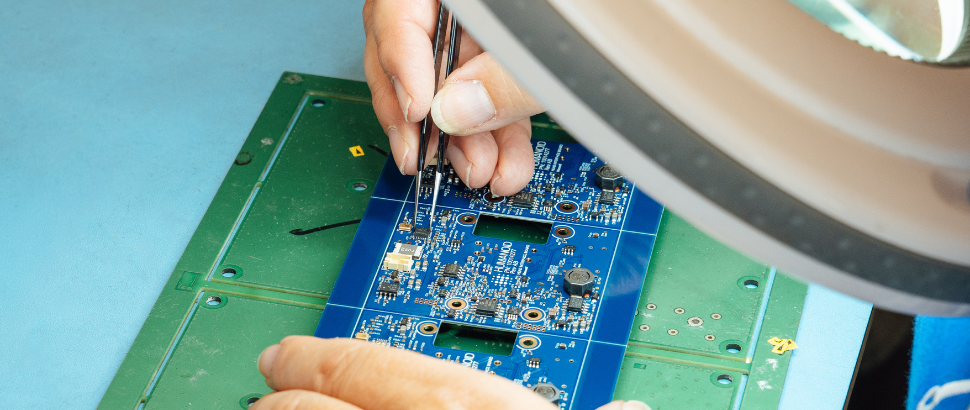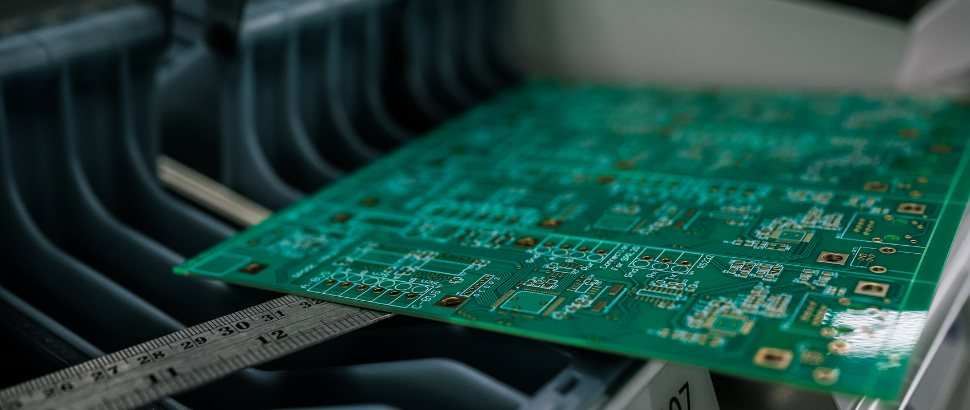News, Blogs & Articles

Consigned Components vs Full Turnkey: Which Model Works for Your Business?
Case Study
November 12, 2025
When you're selecting a contract electronics manufacturer, one of the most important commercial decisions you'll face is whether to supply your own components (consigned) or have your manufacturer source everything (turnkey). This choice affects your cash flow, quality control, lead times, and ultimately your production costs.
There's no universal right answer. The best model depends on your business size, component complexity, volume requirements, and internal capabilities. Here's what you need to know to make an informed decision.
What's the Difference?
Consigned Component Model - You purchase all components directly from your chosen distributors and ship them to your PCB assembly partner. The manufacturer is responsible only for the assembly process itself.
Full Turnkey Model - Your manufacturer handles complete component procurement based on your bill of materials (BOM). You receive finished, tested boards without managing the supply chain yourself.
Hybrid Model - Some manufacturers, including ABL Circuits, offer flexible arrangements where you consign critical or long-lead-time components whilst the manufacturer sources standard parts. This combines the benefits of both approaches.
The Consigned Component Model
Advantages
Direct Supplier Relationships - If you've already established relationships with authorised distributors, you can leverage existing credit terms, negotiated pricing, and preferred supplier agreements. This is particularly valuable for companies with significant purchasing power or specific distributor requirements.
Component Selection Control - You maintain complete control over component sourcing, which matters when you have strong preferences for specific manufacturers, need to avoid certain suppliers, or require particular component grades (automotive, military, etc.).
Transparency on Component Costs - You see exactly what you're paying for each component, making it easier to identify cost-saving opportunities and understand where your budget is allocated.
Lower Initial Outlay to Manufacturer - Since you're not paying the manufacturer to procure components, the invoice from your assembly partner is lower, which can help with purchase order approvals and budget management.
Disadvantages
Cash Flow Impact - You're paying for components weeks or months before they're assembled into finished products. This ties up working capital, particularly problematic for startups and smaller companies operating on tight budgets.
Supply Chain Management Burden - You're responsible for monitoring component availability, managing obsolescence, coordinating deliveries, and ensuring everything arrives at the manufacturer on time. This requires internal resources and expertise.
Quality Risk - Unless you're purchasing exclusively from authorised distributors, there's risk of counterfeit or out-of-specification components entering your supply chain. Your manufacturer will assemble what you provide, but ultimate responsibility for component quality rests with you.
Procurement Complexity - Managing multiple supplier relationships, each with different lead times, minimum order quantities, and shipping schedules, becomes complex quickly, especially for BOMs with 50+ unique components.
Excess Inventory Risk - You'll need to purchase components with some buffer for assembly yields and future builds. If your product design changes or demand forecasts were optimistic, you're left holding obsolete inventory.
The Full Turnkey Model
Advantages
Simplified Management - You provide a BOM and receive finished boards. Component procurement, inventory management, and supply chain coordination become your manufacturer's problem, freeing your team to focus on product development and sales.
Better Cash Flow - You're not paying for components until they're assembled into products you can sell. This significantly improves working capital, particularly valuable during scaling phases when capital is constrained.
Leveraged Purchasing Power - Established contract manufacturers have relationships with major distributors and often secure better pricing than smaller companies can negotiate independently. These savings frequently offset the manufacturer's markup.
Reduced Component Lead Time Risk - Manufacturers often maintain strategic stock of common components and have visibility into distributor inventory levels, reducing the risk of production delays due to component shortages.
Quality Assurance - Reputable manufacturers source exclusively from authorised distributors, providing traceability and eliminating counterfeit component risk. This is critical for regulated industries like medical devices and aerospace applications.
Expert Guidance - Experienced manufacturers flag potential issues during the quoting process (obsolete components, long lead times, or availability problems) before they impact your production schedule.
Disadvantages
Less Pricing Visibility - You receive a single per-board price rather than itemised component costs. Whilst you can request detailed breakdowns, you don't see the manufacturer's actual procurement costs or markup.
Reduced Direct Control - You're trusting your manufacturer to source appropriate components. For companies with strict supplier requirements or component preferences, this requires clear specification and ongoing communication.
Potential Cost Premium - Manufacturers mark up components to cover procurement costs, inventory risk, and profit margin. For companies with excellent distributor relationships or very high volumes, this markup might exceed their own procurement advantages.
Dependency on Manufacturer's Supply Chain - If your manufacturer encounters component sourcing challenges, your production schedule is affected. You're reliant on their capabilities and relationships rather than your own.
Which Model Suits Your Business?
Consigned Makes Sense When:
You have established distributor relationships with negotiated pricing that genuinely beats what a contract manufacturer can achieve. This typically applies to larger companies with significant annual electronics spend.
You require specific component sources due to regulatory requirements, qualification processes, or company policies that mandate approved vendor lists.
You're producing very high volumes where even small percentage savings on component costs translate to significant absolute savings that justify the internal management overhead. For insight into production at different scales, see our guide to small-scale PCB manufacturing.
You have existing component inventory from previous production runs that you need to consume rather than purchasing new stock.
You have internal procurement expertise and the resource capacity to manage complex supply chains without impacting other business priorities.
Turnkey Makes Sense When:
You're a startup or smaller company where working capital is constrained and tying up cash in component inventory creates financial strain.
Your internal team lacks electronics procurement experience or doesn't have bandwidth to manage supplier relationships, lead times, and inventory planning.
You're dealing with component shortage challenges. An experienced manufacturer's purchasing power and strategic inventory helps navigate current market conditions. Read more about overcoming supply chain challenges.
Speed to market is critical and you need to offload supply chain complexity to focus on product development, customer acquisition, and business growth.
You're entering regulated industries where component traceability and counterfeit prevention are essential, and you need a partner with established quality systems.
You value risk transfer - if components become obsolete or unavailable mid-project, a turnkey manufacturer bears responsibility for sourcing alternatives.
Hybrid Models Offer Flexibility
Many companies find that a hybrid approach delivers the best balance. You might consign critical, long-lead-time components (specialised ICs, custom transformers) where you need control, whilst your manufacturer sources commodity components (passives, connectors, standard ICs) where their purchasing power and inventory management add value.
This is particularly effective for prototyping, where you might have engineering samples of key ICs but prefer turnkey sourcing of everything else. As you move into production, you can adjust the model based on volumes and commercial considerations.
Making the Decision: Key Questions
Before committing to either model, consider:
- What's your true component procurement cost? Include not just component prices but also shipping, customs, handling time, inventory storage, and the salary cost of staff managing procurement.
- How does your manufacturer handle component obsolescence? When a component becomes unavailable mid-project, who finds alternatives and who bears the cost of design changes if needed?
- What quality standards does your manufacturer follow? Ask about their counterfeit prevention procedures and whether they source exclusively from authorised distributors.
- How transparent is pricing? Can you get detailed component cost breakdowns to verify you're receiving fair value?
- What's your inventory risk tolerance? If market demand doesn't materialise or your design requires revision, can you afford to write off consigned components?
- Do you have the internal capability? Honestly assess whether your team has the expertise and capacity to manage complex electronics procurement alongside other priorities.
Component Sourcing During Shortages
The global semiconductor shortage has highlighted vulnerabilities in electronics supply chains. During periods of component scarcity, the model you choose significantly impacts your ability to maintain production. We've written extensively about how to overcome the global semiconductor shortage and why your PCB contract manufacturer should source your components.
Established contract manufacturers often have advantages during shortages: strategic component inventory, broker networks for hard-to-find parts, and visibility into distributor allocation systems. If you're managing procurement yourself, you're competing directly with large manufacturers for limited component availability.
However, if you've established strong distributor relationships and secured forward allocations of critical components, consignment allows you to ensure those parts reach your production line rather than being allocated elsewhere.
The Role of Component Procurement in PCB Assembly
Understanding how component sourcing integrates with the broader manufacturing process helps clarify why this decision matters. When manufacturers handle procurement as part of PCB assembly services, they can optimise the entire workflow by scheduling component deliveries to match production slots, managing just-in-time inventory, and coordinating between design requirements and component availability.
For complex projects requiring PCB design support, turnkey manufacturing allows your design team to collaborate directly with procurement specialists, ensuring component selection considers both performance requirements and supply chain realities.
What ABL Circuits Offers
We've worked with clients using consigned, turnkey, and hybrid models for over 40 years. Our approach is flexible. We adapt to what makes commercial sense for your business rather than forcing a one-size-fits-all solution.
For turnkey projects, we source exclusively from authorised distributors, provide full component traceability, and flag potential supply chain issues during the quoting process. We maintain strategic inventory of common components to accelerate turnaround times.
For consigned projects, we provide detailed receiving inspection, moisture-sensitive device handling, and clear communication about any component quality concerns before assembly begins.
Most importantly, we're transparent about which model we believe serves your interests best. If we think consignment makes more sense for your specific situation, we'll tell you, even though turnkey typically generates higher revenue for us.
Making Your Decision
There's no wrong choice here, only the choice that's wrong for your specific circumstances. Consider your business stage, internal capabilities, volume requirements, and cash flow situation.
Many companies evolve their approach as they scale. Starting with turnkey manufacturing when capital and expertise are limited, then moving to consigned or hybrid models as volumes increase and internal procurement capabilities develop, is a common progression. Understanding the benefits of outsourcing PCB assembly can help inform this journey.
The key is choosing a manufacturing partner flexible enough to adapt as your needs change. Whether you're producing prototypes or scaling to volume production, the right sourcing model supports your broader business objectives rather than creating unnecessary constraints.
If you're uncertain which model suits your business, get in touch. We're happy to discuss your specific situation and recommend the approach that makes commercial sense. No obligation, just practical advice based on four decades of electronics manufacturing experience.
Request a quote or call us on 01462 894 312 to discuss your component sourcing requirements.
News, Blogs & Articles















